There are different types of saw that you can find available in your local hardware store, each of which has different uses. The most common type is a handsaw, which along with hammers and screwdrivers, form part of the basic home DIY kit.

For some types of work, modern power tools are not always going to be the answer, and sometimes people need to revert back to a couple of tools that rely on muscle power, such as a hacksaw for cutting through piping or a handsaw, which is generally used for cutting wood.
What is a Reciprocating saw?
One of the most powerful saws, aside from the chainsaw, is a reciprocating saw, which is generally used for demolition purposes, and is a powerful replacement for something such as a crowbar. They are used to rip out fittings from walls, plumbing, windows, doors and other elements of a structure. If you are working on a remodeling project at home, or are repairing part of a structure, a reciprocating saw is going to be a handy tool for your arsenal, and it going to provide a great deal of assistance. It can cut through wood, stone and metal, using it’s forth and backwards motion, hence where its name comes from. Some of the most powerful reciprocating saws can reach over 2500 SPM (strokes per minute), and it is this power and ability to cut through so many different types of structure that make it ideal for demolition work.
Different uses for a reciprocating saw
Due to its ability to cut through a variety of materials, there are a large number of jobs that you can accomplish, with a reciprocating saw. If you are on the lookout for a reciprocating saw, but not sure which one to go for, then click here and check through the detailed reviews that can help you decide.
Straight or curved cuts
Though you can achieve straight or curved cuts with most saws, the advantage that a reciprocating saw has over the others is that it can get into places that a regular saw cannot. The compact design makes it ideal for those difficult to reach places, and it can make such cuts on either metallic or wooden surfaces. Even if the wood or metal that you are planning to cut through has nails or screws going through it, you can easily make your cuts with the reciprocating saw without giving it a second thought. One thing to remember though when it comes to flexibility in cutting wood, is that for more accurate results, your best option will be a jigsaw. A jigsaw is much easier to control for cutting very specific curves and shapes. But for demolition work, the reciprocating saw is going to be your savior.
Plumbing and piping
Most types of plumbing work is going to involve metal piping, and in most instances, you’ll need to be able to quickly cut through it. Most plumbers will have a reciprocating saw as one of the most important parts of their tool set, and it’s ability to cut through notches and holes make it perfect for all types of plumbing work that you might need to carry out. In the past you might have had to use a small hacksaw to cut through piping, which would have taken a fair bit of muscle work, but with a reciprocating saw, you can be done in seconds.

Pruning trees and cutting branches
If you have a large garden, then you’ll know all about the need for pruning and managing your trees. The cordless reciprocating saw is the best option for this type of work, as you don’t want the power cable to get tangled up amongst the branches you’ll be cutting down. The saw can be used to trim overgrown branches and you can easily prune the trees, even if they are at awkward angles. For this type of work, there isn’t a better type of saw that you can use, though if you need to reach branches that are very high up, then it’s worth investing in a pole saw as well.
Construction or demolition work
As mentioned earlier, a reciprocating saw is ideal for different types of demolition work that you might need to do, with its powerful blade being ideal for demolishing things and pulling out fittings. It’s also very handy for construction work as well, and can be used for work such as roofing, where you can trim shingles to fit perfectly on the top of the house. It’s a tool that is so popular due to its power and versatility, that you will be hard pushed to find any construction or demolition work taking place where such a saw isn’t being used.
Different techniques for different saws
It’s important to remember that not all reciprocating saws are the same, and the way you use them will have an effect on the final results of your work. Wireless saws are the best option for any outdoor work you want to do, whether it be in the garden or on the roof. For indoor work, such as ripping out fittings from walls, then the wired version is going to be your best bet. The blades you can attach to your saw are different as well, so you need to make sure that you are using the correct blades for the type of work that you want to do. Use the wrong ones, and you’ll not only destroy the blades, but you could also do damage to the saw itself.
Taking care when working
For your own safety when using a reciprocating saw, it’s important to wear eye protection, and if cutting through metal, use some ear plugs as well, as the noise can be pretty intense. Remember to unplug your saw when changing the blade or any other accessories, and also don’t forget that when the saw is in use, the blade can generate quite a lot of heat, so if you’ve just finished cutting through something, don’t make a grab for the blade as you could seriously burn yourself.






